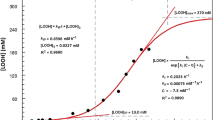Abstract
The peroxidation of different polyunsaturated fatty acids (PUFA) after photoirradiation in aqueous solution was evaluated by measuring fatty acid loss and malonaldehyde production in medium. The oxidation rates of eicosapentaenoic acid (EPA) and docosahexaenoic acid (DHA), two highly unsaturated fatty acids of the n−3 series, were surprisingly lower (14 and 22%, respectively) than the oxidation rates of linoleic, α-linolenic, γ-linolenic, dihomo γ-linolenic, and arachidonic acids (62–90%). The quantities of malonaldehyde (MA) produced were assayed simultaneously by gas chromatography (GC) and high performance liquid chromatography (HPLC). MA production was found to be related to both the degree of unsaturation and the metabolic series of the fatty acid. The maximum value was observed with arachidonic acid (MA production from 2 mM arachidonic acid in aqueous solution was estimated at 44.9±6.0 μM by GC and 46.8 ±4.0 μM by HPLC). Eicosapentaenoic acid and docosahexaenoic acid produced lower MA quantities compared to arachidonic acid (MA production from 2 mM EPA and 2 mM DHA was estimated at 17.9±1.5 μM and 37.9±0.7 μM, respectively, by GC, and 26.3±4.9 μM and 37.3±4.2 μM, respectively, by HPLC). The MA yield, defined as the amount of MA (nmols) produced per 100 nanomoles of oxidized fatty acid, was used to express the susceptibility of individual PUFA to peroxidation. The MA yield correlated well with the degree of unsaturation, but was independent of carbon chain length and metabolic series. The study suggests that adequate assessment of lipid peroxidation cannot be achieved by measuring MA formation alone, but it also requires knowledge of the fatty acid composition of the system studied.
Similar content being viewed by others
Abbreviations
- AA:
-
acetylacetone
- DHA:
-
docosahexaenoic acid
- EPA:
-
eicosapentaenoic acid
- FID:
-
flame ionization detector
- GC:
-
gas chromatography
- BBT:
-
2-hydrazinobenzothiazole
- HBT-AA:
-
2-(3′,5′-dimethylpyrazol-1′-yl)benzothiazole
- HBT-MA:
-
2-(pyrazol-1′-yl)benzothiazole
- HPLC:
-
high performance liquid chromatography
- MA:
-
malonaldehyde
- NPD:
-
nitrogen phosphorus detector
- PUFA:
-
polyunsaturated fatty acids
- TBA:
-
thiobarbituric acid
- TMP:
-
1,1,3,3-tetramethyoxypropane
References
Halliwell, B., and Gutteridge, J.M.C. (1985)Free Radicals in Biology and Medicine, p. 139, Oxford University Press, New York.
Bachowski, G.J., Thomas, J.P., and Girotti, A.W. (1988)Lipids 23, 580–586.
Dahle, L.K., Hill, E.G., and Holman, R.T.,Arch. Biochem. Biophys. 98, 253–261.
Pryor, W.A., Stanley, J.P., and Blair, E. (1976)Lipids 11, 370–379.
Olivieri, O., Negri, M., de Gironcoli, M., Bassi, A., Guarini, P., Stanzial, A.M., Grigolini, L., Ferrari, S., and Corrocher, R. (1988)Scand. J. Clin. Lab. Invest. 48, 659–665.
Hebbel, R.P., and Miller, W.J. (1988)Am. J. Hematol. 29, 222–225.
Gutteridge, J.M.C. (1982)Int. J. Biochem. 14, 649–653.
Beljean-Leymarie, M., and Bruna, E. (1988)Anal. Biochem., 173, 174–184.
Umano, K., Dennis, K.J., and Shibamoto, T. (1988)Lipids 23, 811–814.
Ekström, T., Garberg, P., Egestad, B., and Hogberg, J. (1988)Chem.-Biol. Interactions 66, 177–187.
Hirayama, T., Yamada, N., Nohara, M., and Fukui, S. (1984)J. Sci. Food Agric. 35, 289–296.
Csallany, A.S., Der Guan, M., Manwaring J.D., and Addis, P.B. (1984)Anal. Biochem. 142, 227–283.
Bull, A.W., and Marnett, L.J. (1985)Anal. Biochem. 149, 1 284–290.
Esterbauer, H., Lang, J., Zadravec, S., and Slater, T.F. (1984)Methods Enzymol. 105, 319–328.
Bird, R.P., and Draper, H.H. (1984)Methods Enzymol. 105, 299–305.
Melø, T.B., and Mahmoud, G.S. (1988)Magn. Reson. Chem. 26, 947–954.
Ahmed, A.A., and Holub, B.J. (1984)Lipids 19, 617–624.
Cillard, J., and Cillard, P. (1980)J. Am. Oil Chem. Soc. 57, 39–52.
Folch, J., Lees, M., and Sloane Stanley, G. (1957)J. Biol. Chem. 226, 497–509.
Hagenfeldt, L. (1966)Clin. Chim. Acta 13, 266–268.
Smith, J.B., Ingerman, C.M., and Sylver, M.J. (1976)J. Lab. Clin. Med. 88, 167–172.
Holme, D.J., and Peck, H. (1983)Analytical Biochemistry, pp. 8–15, Langmann Inc., New York.
Cosgrove, J.P., Church, D.F., and Pryor, W.A. (1987)Lipids 22, 299–304.
Kim, R.S., and LaBella, F.S. (1987)J. Lipid Res. 28, 1110–1117.
Manwaring, J.D., and Csallany, A.S. (1988)Lipids, 23, 651–655.
Author information
Authors and Affiliations
About this article
Cite this article
Bruna, E., Petit, E., Beljean-Leymarie, M. et al. Specific susceptibility of docosahexaenoic acid and eicosapentaenoic acid to peroxidation in aqueous solution. Lipids 24, 970–975 (1989). https://doi.org/10.1007/BF02544543
Received:
Accepted:
Issue Date:
DOI: https://doi.org/10.1007/BF02544543




